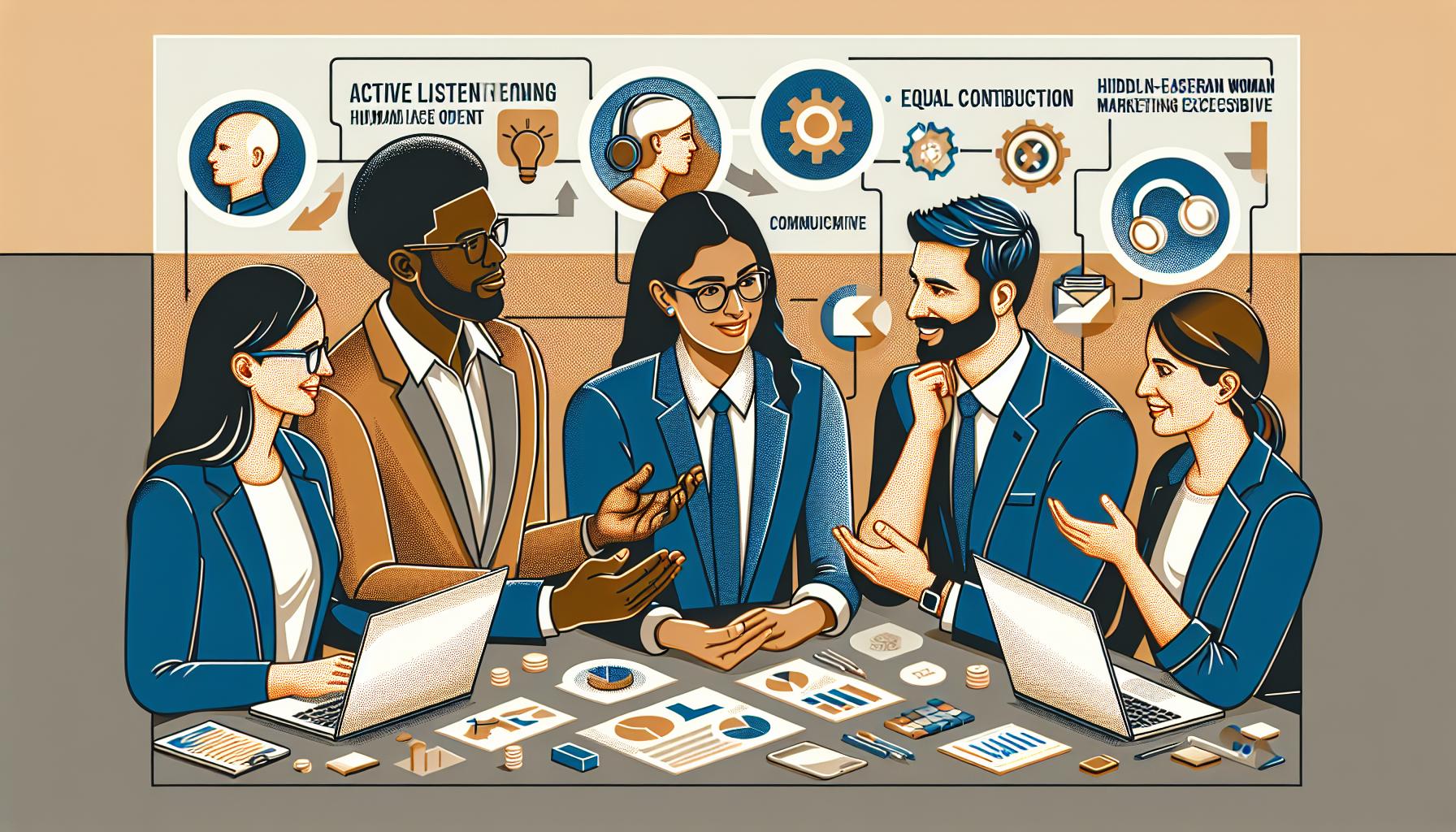Gender Barriers to Communication: Key Strategies
In today’s world, effective communication is key to fostering understanding and collaboration. Yet, gender barriers often muddy the waters, making meaningful exchanges more challenging than they need to be. It’s not about what’s innate to us as individuals but rather the social and cultural constructs that shape our interactions.
Gender barriers to communication arise from societal expectations and stereotypes, influencing individuals’ expression, reception, and interpretation of messages, often leading to miscommunication and misunderstanding.
Understanding these barriers is the first step towards dismantling them. By recognizing the impact of gender on communication, we can work towards creating environments that value and promote inclusivity. This isn’t just about making conversations easier; it’s about enriching our connections with diverse perspectives and experiences. Let’s dive into what these barriers look like and how we can overcome them together.
Key Takeaways
- Understanding and Dismantling Gender Stereotypes: Recognizing the impact of gender stereotypes on communication is crucial for fostering inclusivity and promoting diverse perspectives in both personal and professional settings.
- Adapting to Nonverbal Communication Differences: Being aware of and adapting to the different ways men and women use nonverbal cues can significantly reduce misunderstandings and enhance communication equity.
- Empowering Assertiveness and Confidence Across Genders: Encouraging and valuing assertiveness and confidence in communication, regardless of gender, can help overcome biases and promote a more balanced workplace environment.
- Addressing Power Dynamics and Gender Inequality: Acknowledging and actively working to offset the impact of power dynamics and gender inequality is essential for equitable and effective communication.
- Valuing Different Communication Styles: Understanding and leveraging the unique strengths of task-oriented and relationship-oriented communication styles can lead to more effective and inclusive interactions.
- Promoting Active Listening and Empathy: Fostering an environment that emphasizes the importance of active listening and empathy is key to bridging gender differences and achieving meaningful communication.
Gender Barriers to Communication

In my years of experience studying and writing about effective communication, I’ve observed that gender barriers significantly impact how we interact and understand each other in various settings. Let’s delve deeper into the nuances of these barriers.
Stereotypes and Expectations
One of the most pervasive examples of gender barriers in the workplace and beyond stems from stereotypes and expectations based on gender. These preconceived notions about how men and women should behave often limit individual expression and foster an environment ripe for misinterpretation and bias. For instance, expecting women to be more passive can lead to their contributions being undervalued or ignored, while men may feel pressured to avoid showing vulnerability. Tackling these stereotypes is crucial for creating an inclusive communication environment that values diverse perspectives.
Nonverbal Communication
Nonverbal Communication plays a significant role in how gender differences impact communication. Women and men tend to display and interpret nonverbal cues differently, which can lead to misunderstandings. For instance, men might use more expansive gestures or claim more personal space, while women might rely more on facial expressions and maintain higher levels of eye contact. Recognizing and adapting to these differences can improve understanding and foster more equitable communication.
Assertiveness and Confidence
Assertiveness and confidence in communication often get tangled with gender expectations, potentially creating barriers. Men are generally encouraged to be assertive and confident, qualities that are positively received in many professional settings. Women displaying the same characteristics might face negative stereotypes, being labeled aggressive or domineering. This disparity not only affects communication but also contributes to broader gender bias in the workplace.
Power Dynamics and Gender Inequality
Power dynamics and gender inequality are interwoven, significantly affecting communication. In environments where gender inequality is prevalent, such as noticeable gender pay gaps, communication styles may be influenced by the underlying power imbalances. Women may feel less empowered to speak up or may have their opinions discounted more frequently due to their gender, perpetuating gender barriers in the workplace.
Differences in Communication Styles
Understanding the differences in communication styles based on gender is crucial for fostering effective exchanges. Men often engage in more task-oriented communication, while women might prioritize relational aspects, focusing on empathy and collaboration. Recognizing and valuing these differing approaches can lead to more inclusive communication strategies that leverage the strengths of each style.
Differences in Language Use between Genders
Lastly, the differences in language use between genders can also influence how messages are conveyed and received. Women might employ a more collaborative language, using qualifiers or questions to involve others, while men might utilize a more direct and assertive tone. These differences don’t inherently hinder communication but highlight the importance of an environment that fosters open communication, allowing all parties to express themselves authentically without fear of judgment or misunderstanding.
As we continue to explore the dynamics of gender communication, it’s evident that cultivating an awareness of these barriers and actively working to overcome them is essential for achieving truly effective and equitable communication. Removing these barriers requires commitment to open, honest communication and a willingness to challenge our own biases and assumptions.
How to overcome Gender Barriers of Communication

In the pursuit of equitable communication, it’s imperative that we address and overcome gender barriers that impede effective dialogue in both personal and professional spheres. The complexity of gender communication differences can’t be overstated, and while progress has been made, gender barriers haven’t vanished. They subtly persist in ways that often go unnoticed but significantly affect communication. Here, I’ll share insights and strategies that can help us navigate and dismantle these barriers.
Awareness and Education
Understanding the impact of gender on communication is the cornerstone of overcoming communication barriers. Gender affects communication styles profoundly, influencing everything from the choice of words to nonverbal cues. Recognizing examples of gender barriers in the workplace and beyond is the first step toward fostering an inclusive communication environment.
Education plays a crucial role here; by learning about gender communication differences and the various types of gender barriers, individuals and organizations can begin to implement changes that promote gender equality in dialogue. Awareness initiatives can help debunk myths about ‘common communication’ styles being specific to a gender, revealing instead a rich tapestry of individual differences unbound by gender stereotypes.
Active Listening and Empathy
Active listening and empathy are powerful tools against gender biases in the workplace and elsewhere. By fostering an environment that values open and honest communication, we encourage individuals to share their perspectives free from the fear of bias based on their gender.
Active listening involves giving full attention to the speaker and seeking to understand their viewpoint, a practice that’s vital for uncovering and addressing issues related to gender barriers in communication. Similarly, empathy allows us to connect with others on a deeper level, acknowledging their feelings and experiences. This emotional intelligence is key to bridging gender differences and promoting inclusive communication.
Recognizing and Challenging Bias
Gender bias in the workplace and other areas of life can create insurmountable barriers to effective communication. These biases are often ingrained in cultural norms and institutional policies, making them challenging to identify and address.
However, recognizing and challenging these biases is crucial for creating equitable communication. We must be vigilant in identifying instances where gender bias affects communication, whether through assumptions about individuals’ communication styles or the undervaluation of contributions due to their gender.
Challenging these biases involves questioning stereotypes related to gender, encouraging task-oriented communication that focuses on abilities rather than gender, and promoting policies that ensure gender equity. By actively working to dismantle these barriers, we not only improve communication but also contribute to a more just and inclusive society.
In sum, overcoming gender barriers to communication isn’t a straightforward task. It requires a multifaceted approach that includes raising awareness, practicing active listening and empathy, and steadfastly challenging biases. By committing to these strategies, we pave the way for more genuine and impactful exchanges across all areas of life.
Examples of gender barriers

When discussing gender barriers to communication, it’s crucial to recognize real-world examples. These barriers often stem from societal norms and can significantly impact communication in both personal and professional settings.
One key example lies in task-oriented vs. relationship-oriented communication. Traditionally, men are seen as more task-oriented, focusing on the goal of the conversation, while women tend to be more relationship-oriented, emphasizing the interaction’s emotional aspects. This difference can lead to misunderstandings, where one party might view the conversation as impersonal, while the other sees it as lacking depth.
Nonverbal communication also showcases gender differences. Research indicates that women are generally more adept at reading and conveying emotions through facial expressions and body language. This skill can sometimes cause misinterpretations in mixed-gender interactions if gestures or nonverbal cues are not understood across gender lines.
In the workplace, gender bias is a significant barrier. Despite advancements towards gender equality, gender barriers in the workplace remain pervasive. The gender pay gap is a glaring example, where women are still paid less than men for the same work. This disparity reinforces gender stereotypes and undermines efforts towards equitable communication.
Stereotyping is another hurdle. For instance, women are often stereotyped as being too emotional in professional settings, a bias that can diminish the perceived validity of their contributions. Men, conversely, might be stereotyped as overly aggressive, which can hinder the development of an environment that fosters open and honest communication.
Communication patterns related to gender play a role too. Men’s communication styles are often seen as more direct and assertive, while women’s are viewed as more cooperative and nurturing. These stereotypes can create gender barriers, as individuals might be expected to adhere to these styles based on their gender, rather than their personal communication preferences.
Understanding these examples is essential for fostering an inclusive communication environment. Recognizing these barriers allows us to address them effectively, opening pathways to more genuine and impactful exchanges across gender lines.
Conclusion
Overcoming gender barriers in communication isn’t just about breaking down walls—it’s about building bridges. By recognizing and challenging our biases we open the door to more authentic and meaningful interactions. It’s clear that the journey toward inclusive communication requires effort from all of us.
Whether it’s through education awareness or simply practicing empathy we’ve got the tools we need to start making a difference today. Let’s commit to using them. After all genuine communication is the key to understanding and respect across the gender spectrum. Together we can create an environment where everyone’s voice is heard and valued.






